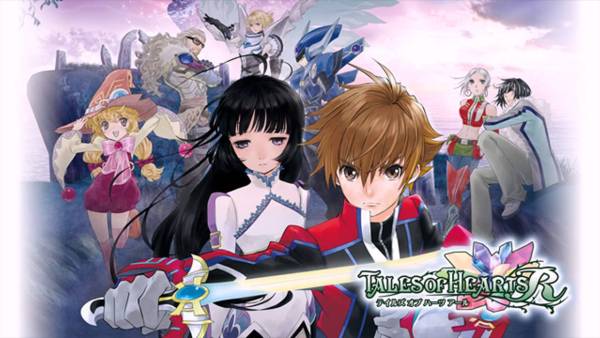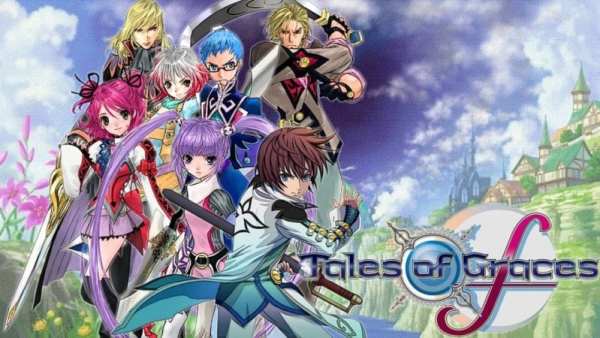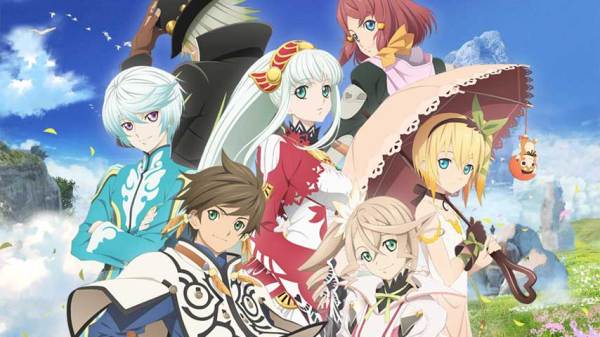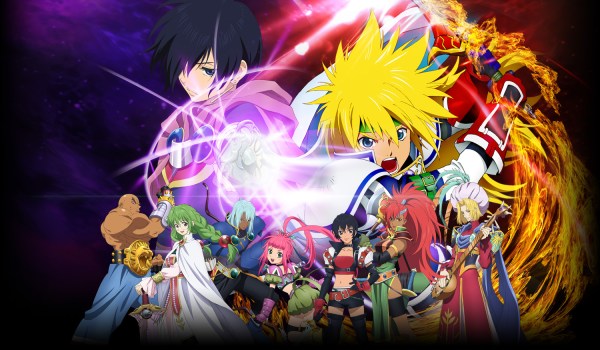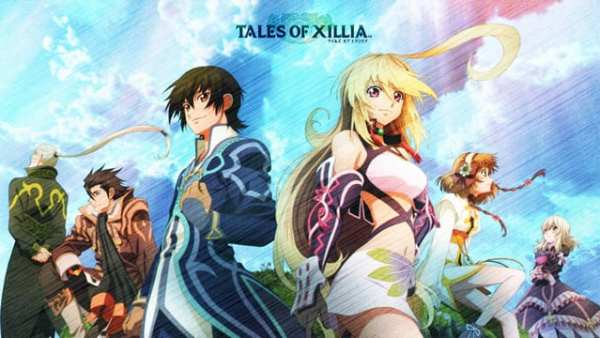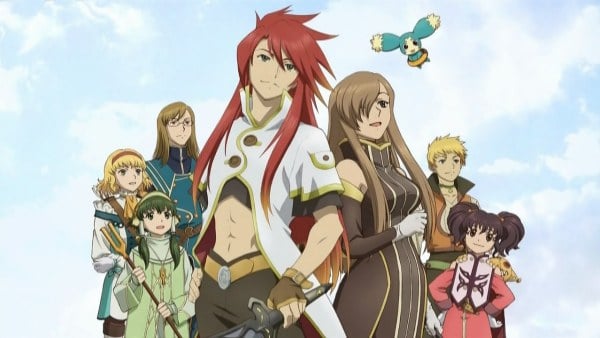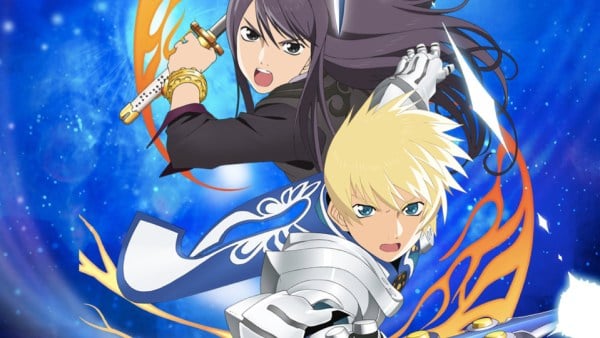Here are the best Tales of Games, all 15 of them ranked. Note that this list is only for the Tales of games released in North America up to this point.
15) Tales of the World: Radiant Mythology
Best Tales of Games
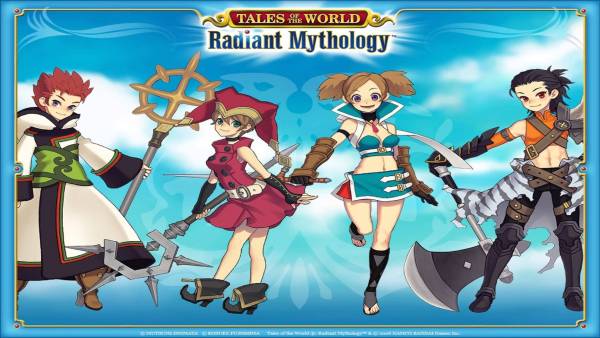
Radiant Mythology is more of a spinoff of the Tales series rather than a mainline entry. Although there are two more Radiant Mythology games in Japan, this is the only one the west ever saw.
For the first time, players were able to create their own character and could customize stats, appearance, weapons, etc. There’s a heavy emphasis on players interacting with characters from across the Tales series, and you can build your party from any number of them.
Characters from games, like Symphonia, Abyss, Destiny, Eternia, and more make appearances.
Your avatar is tasked with trying to save the world of Terresi from a “devourer.”
The main story doesn’t really come together cohesively, though, and the focal point of the game is definitely seeing characters from across different games interact.
Radiant Mythology definitely has replay value, but nothing in the game, including story and combat, feels as tight as a regular Tales entry.
14) Tales of Symphonia: Dawn of the New World
Best Tales of Games
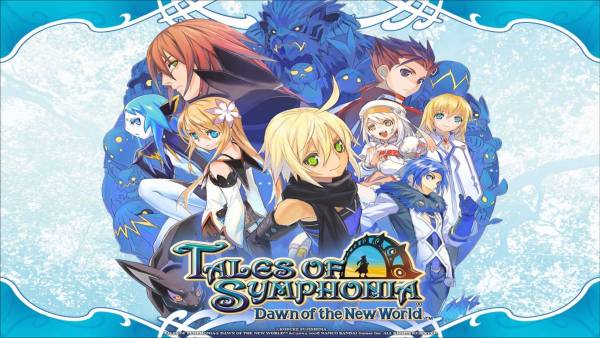
Years after Tales of Symphonia took the RPG world by storm, we’d get a direct sequel. Releasing on the Wii, Dawn of the New World follows two brand new characters named Emil and Marta.
The two cross paths with all of the main characters from Symphonia at some point, but a new monster capturing system serves the bulk of party building.
The story builds off of the events of Symphonia, with the worlds of Sylvarrant and Tetheala now combined into one. Emil and Marta find out about the Centurion Spirits and the powerful spirit Ratatosk.
Emil becomes a “Knight of Ratatosk” gaining a direct link to the spirit, who at times possesses Emil’s body.
Dawn of the New World’s combat takes place on an onmi-directional plane allowing players to move around the battlefield rather than just a straight line like the original.
The game does some interesting things with the story, like Emil believing Lloyd Irving to be a villain, but ultimately Emil and Marta just aren’t as interesting of characters as Symphonia’s ensemble cast.
It has some good monster mechanics, but using monsters in battle doesn’t lead to as much of a connection as you would have with party characters.
Dawn of the New World is a flawed sequel, but it’s good to see some of the memorable characters from Symphonia return again.
13) Tales of Legendia
Best Tales of Games
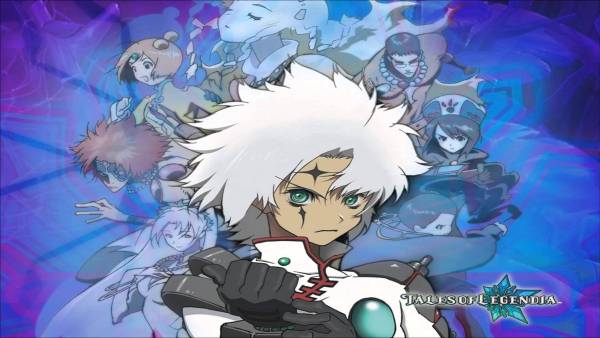
Legendia is one of the few Tales titles where the gameplay is more of a draw than the story.
Taking place on a world covered in water that’s actually a ship from an ancient civilization. Senel Coolidge is the main character, as he tries to save his sister Shirley from a group that believes her to be a prophesied savior.
There’s an interesting feature here that separates Legendia from other Tales games.
After beating the main story, a series of scenarios are added that focus on expanding individual characters. Legendia has some strong characters with a few exceptions, but the main story is mostly derivative with few surprises.
The battle system takes a cue from some of the older titles and puts battles on a 2D, linear plane. The system feels more like a fighting game than an RPG in the best way.
Battles are incredibly fun and there’s a lot of room to grow characters and utilize different skills.
One of the best features of Legendia is its incredible soundtrack, which may be the best in the series even considering some of its competition. The music fits the mood of the game perfectly, really giving Legendia a feel of its own.
The party is interesting in and of themselves and the details that spring up from their interactions are frequently interesting, but a layer of predictability and backtracking within the game are present as well.
12) Tales of Destiny II (Eternia)
Best Tales of Games
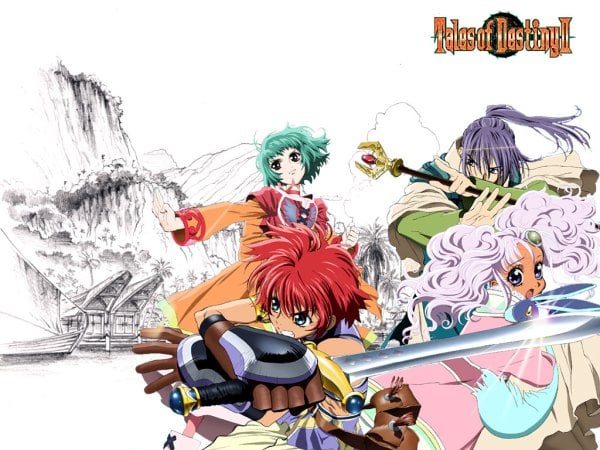
Tales of Destiny II was the second game to hit North America, but was actually called Tales of Eternia in Japan. There is in fact a Tales of Destiny II that follows up on the first game, but unfortunately the west never saw a release of it.
Eternia’s battle system feels like an expanded version of the previous games, with battles players controlling their character in real time.
There’s also a detailed system allowing characters to heavily influence how the AI teammates act in battle. Although it may feel a bit dated now, Eternia’s combat was a nice shift from traditional turn based gampeplay at the time it came out.
Eternia plays host to a hunter named Reid Herschell and his friends, as they discover a mysterious girl who speaks another language.
They find out she’s from another realm known as Celestia, which they cross a dimensional boundry to get to.
They become embroiled in a war between two worlds, and meet characters from both along the way.
The story is definitely emphasized less than its predecessor, Destiny, although in Tales fashion, the party still has interesting dynamics. Eternia also hit at a time when voice acting was still fairly new to video games, and it shows.
The voice acting isn’t necessarily terrible, but a sense of urgency is never conveyed by the actors even in dramatic life-or-death situations.
Pieces of Eternia may not hold up, but it still has a great battle system and some fun characters. It’s worth going back to and having look at if you happened to miss it before now.
11) Tales of Hearts R
Best Tales of Games
The ways North America has gotten Tales games have been a bit weird at times, and Tales of Hearts is a perfect example of that.
Hearts actually released on the Nintendo DS in 2008 for Japan, and would later see a remake on the Vita called Tales of Hearts R in full 3D.
That version is what the west would see in 2014 on the PlayStation Vita, with only Japanese voice tracks.
Kor Meteor takes the main role, as a young boy who lives in a secluded village. When a girl named Kohaku comes to their village his life gets turned upside down.
Ultimately the plot of Hearts comes down to Kor and the party traveling around the world to find pieces of Kohaku’s shattered heart.
The idea of two different worlds comes into play with this game as well, and a strong ensemble cast helps propel the story forward.
Many of the themes in Hearts have to do with emotion, and people finding those pieces of themselves.
The battle system of Hearts has a strong emphasis on aerial combos, with characters being able to combine attacks as well.
A deep customization system that involves characters’ main weapons, known as “soma,” helps diversify the potential you have in battle.
Heart’s story may be a bit wandering, but the cast builds real camaraderie, and the game keeps a level of humor throughout the experience that’s unique even for a Tales game.
It’s a character-focused story, that has some real charm to it especially as you see more of each characters back story
10) Tales of Graces F
Best Tales of Games
Graces may have one of the best combat systems ever seen in a JRPG. It employs what it calls the “Style Shift Linear Motion Battle System,” giving players different styles for burst artes and assault artes mapped to two different buttons.
Each action uses up CC, that players have a limited amount of this but can gain some back by standing still or guarding.
The battle system in Graces truly does get better the further you get into the game, as new layers and skills are added on the whole time.
Each party character functions integrally different, and has their own defined strengths and weaknesses.
Asbel Lhant is a swordsman and the main character of the story, which involves him and his friends discovering an amnesiac girl named Sophie outside of their city of Lhant.
Graces central theme is friendship, and this comes through at every step of the game. Conversations bring it up, the central conflict between Asbel and his possessed childhood friend Richard embodies it, and the theme continually comes up.
Graces F is an upgraded version of the game that originally released on the Wii.
There’s also a significant second after-story that opens up after the main game called Lineages and Legacies.
This adds a few hours onto the end of the game, reunites the party after the story and adds Richard as a playable character.
Graces may not be the grandest of Tales stories, but its charming focus on friendship leads to some fun interactions from the party.
The battle system only expands and becomes even more addicting as the game goes on, making Graces at least one of the most fun Tales titles to play.
9) Tales of Phantasia
Best Tales of Games
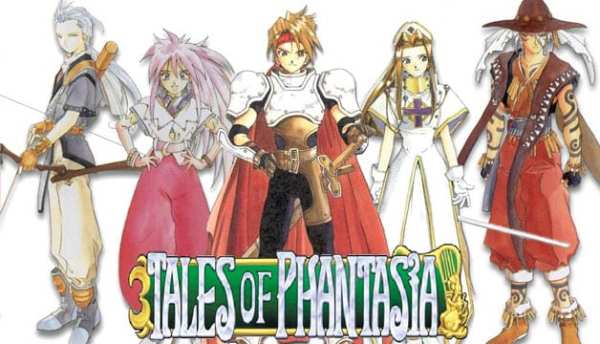
This is where it all began for the Tales series, on the Super Famicom in 1995. Unfortunately, North America wouldn’t see the game until years later when it released on the Game Boy Advance in 2006.
Much of what each Tales game draws from started here; a character-based story, fast real time combat, and other themes like the presence of elves in the world.
The story starts as four legendary heroes are locked in battle with the evil sorcerer Dhaos. Before he’s defeated, Dhaos uses a spell to travel into the future where he runs into the heroes descendants who lock him away.
The main character of Phantasia is Cress, a young man living in a quiet village. Through some circumstances Cress his friend Chester and a girl named Mint are thrust into a struggle against Dhaos.
Phantasia has its characters time hopping between the past and present as they fight Dhaos and his evil forces.
Phantasia also introduces the fast-paced fighting system the series would expand on, as players control one character directly in real time and can use an assortment of attacks and artes.
Phantasia is dated by all standards, graphics, gameplay, storytelling. However, the story and characters have enough of a draw to pull you into the experience easily.
8) Tales of Zestiria
Best Tales of Games
Zestiria is one of the newest game of the series to hit PS3 and PS4, and as such it tries to do some different things.
The presentation is better than ever, with cutscenes blending well with actual gameplay and an open world layout rather than the traditional world map.
Zestiria casts you as a man named Sorey who’s lived his entire life in a village filled with a spirit race known as Seraphim.
Sorey finds out that he’s what is known as “The Shepard,” the one who saves the world from malevolence and darkness. Sorey is one of the only humans in the world that can see and speak to Seraphim, as most believe them to be gods.
Tributes and worship of the Seraphim have waned over the years though, weakening their protection and power. Shepards can contract sub-lords who are also able to speak to the Seraphim and use their power through the Shepard.
Sorey, his childhood friend Mikleo, and others set out to travel around the world purifying what’s known as “Hellions.”
Two human characters serve in battle, and you have access to up to four Seraphim to switch out in battle two at a time. Humans specialize in close range combat artes, while Seraphim specialize in long range magical artes.
Sorey has a power known as “armatize” that lets him combine with a Seraphim and turn into an incredibly powerful being with a whole new set of move.
All of these options as well as being able to switch out Seraphim at will, make Zestiria’s combat system fast and diverse.
Sorey’s story is a tragic one in the end, and the task of being a Shepard weighs continuously on him throughout the game. Zestiria is a bit shorter than other Tales games and doesn’t have a ton of content outside of the main story.
However, it tries new things some of which succeed and is an overall good step forward for the series.
7) Tales of Berseria
Best Tales of Games

Berseria sets a very different tone for the Tales series, making its story and main cast of characters much darker than we usually see. The series continues to up the ante with its presentation, and experiments quite a bit with its battle system.
The story of Berseria focuses on a young girl named Velvet Crowe, living a quiet life in a peaceful village.
Her world gets turned upside down when someone she trusts does something unthinkable, resulting in the loss of the entire village and everything she loves.
Velvet herself is turned into a daemon, an unholy being with special powers, and becomes consumed with vengeance. Three years later Velvet is broken out of prison, and finds the world very different from what she knew.
Along her journey, Velvet meets a colorful ensemble cast, who each have an incredibly troubled past.
The party of Berseria really is a ragtag group from different walks of life, whether it’s the dameon samurai Rokurou, or the pirate Eizen who’s stuck with a curse making him unlucky.
The story has much darker themes from the previous title Zestiria, and the main cast, especially Velvet, aren’t exactly the virtuous heroes. They cheat, steal, kill, and do more to achieve their goals.
Of course, the enemies they’re up against aren’t exactly holy either, resulting in a story filled with more moral grays, rather than black and white.
Combat has been drastically changed for Berseria, no longer splitting up normal attacks and artes as different commands.
Instead, you have four-step combos attached to each of the four face buttons, and a “soul gauge” measure how many moves in a combo you can use.
Each of the four-step combos for each character can be customized, resulting in a lot of combat variation. It’s a deep combat system, that only expands the further you get into the game, unlocking things like Break Artes and Mystic Artes.
Tales of Berseria is a welcome change in tone for the series, and even though its ensemble cast is a bit haphazard, they manage to be incredibly memorable.
Combat is fast and exciting, while also deep and rewarding. It’s another worthy entry in the long-running RPG franchise.
6) Tales of Xillia 2
Best Tales of Games

Xillia 2 was another first for the series with a silent protagonist named Ludger Kresnik.
Ludger is meant as a vessel for the player to put themselves in the story, and at multiple points they’re able to make conversation choices for him.
Interestingly enough, the game plays off of Ludgers silence in some smart ways later in the game providing story reason for it rather than just the gameplay mechanic of a silent protagonist.
Fractured dimensions have started appearing since the events of the first Xillia, throwing time itself unbalanced. The Kresnik family has the ability to infiltrate and destroy these fractured dimensions, so Ludger and his brother are employed by the Spirius Company to do so.
Early in the game Ludger is put into massive debt in exchange for his life being saved, and this is something hanging over you that you have to actually pay off in the game.
One of the best parts of Xillia 2 is the focus that gets put on each returning character. Everyone gets an expanded storyline, and even missions of their own.
Ludger has the ability to switch between three different weapons, swords, guns and a hammer as well as transform into a stronger being.
Combine this with the link system from the last game and you have a highly addictive combat system with a lot of style. Unfortunately, there’s a fair amount of repetition and backtracking in the game, as well.
Xillia 2 did an even better job of developing its cast of characters than the first game did, and gave some new additions to combat.
It may be rough at some times because of repetition, but it’s more than a worthy sequel to Xillia.
5) Tales of Destiny
Best Tales of Games
Tales of Destiny was the first game in the series that North America would ever see. While it wasn’t necessarily a smash hit, its interesting characters and action based combat drew a lot of interest from RPG fans.
Stahn Aileron is a young country boy that wants to be an adventurer, so he stows away on the flying ship Draconis. When a hostile force attacks the ship, Stahn searches for a weapon and stumbles upon a sentient sword named Dymlos.
This sword becomes the catalyst for the adventure Stahn seeks as he travels and meets others of the ancient Swordian race, and quickly becomes embroiled in war.
Some of the most memorable characters of the series come out of Destiny, like Leon, Rutee and Philia.
The linear battle system was vastly different for RPG fans letting them execute attacks and magic spells in real time, even rewarding extra XP for multi-hit combos.
Destiny was the first Tales game to hit America, and it still remains one of the most memorable and charming titles of the series.
4) Tales of Xillia
Best Tales of Games
Xillia was another interesting aside for the series, as it let players choose between two main characters. This choice would change cutscenes, and everything would be seen from that characters perspective.
Jude Mathis, a medical student, and an ethereal being named Mila Maxwell are the main characters. They meet after Mila infiltrates Jude’s city to sabotage a dangerous weapon known as the Lance of Kresnik.
Xillia is set in the world of Rieze Maxia where society has created technology known as Spyrix that uses the power of spirits for energy. This creates a divide between the spirit realm and the human realm.
The cast of characters in Xillia are just as good as ever, with a strong cast of villains to match. Jude and Milla are both interesting in very different ways and they develop an interesting, symbiotic relationship.
Each character has their own specific arc, like Alvin, who betrays the party but ultimately finds his loyalty to them.
Xillia’s battle system also made some fantastic changes.
It introduced the link system that allows two characters to sync up and support each other, as well as use some powerful special moves with the linked artes gauge.
Regular artes and attacks are also dictated by an assault counter similar to graces.
Completing Xillia doesn’t take nearly as long as other Tales titles clocking in at around 40 hours, but it’s a story that gets its point across and isn’t packed with much filler.
It stays exciting throughout and has the gameplay to match.
3) Tales of Symphonia
Best Tales of Games
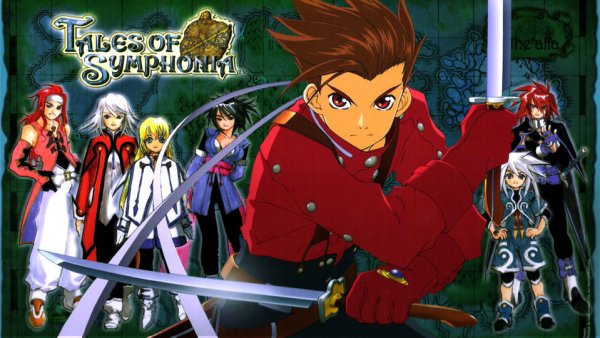
Tales of Symphonia could arguably be the game that really put the series on the map in North America. It was one of the first Tales games to be rendered in 3D, although the battle system is still a linear path in a 3D arena.
Religious themes are heavy in Symphonia as Lloyd Irving accompanies his friend Colette who’s the “Chosen of Regeneration” on her expedition to restore the worlds mana.
Throughout their journey, they find out some surprising truths about the Church of Martel and the state of the world, even finding the existence of a second world called Tethe’alla.
Lloyd is a bit of a goody-two-shoes as a character, but he finds out troubling things about his past and his parents. He’s loyal to the end for his friends, and willing to do anything it takes for them.
Characters join him from across both worlds, with nine party members making this one of the largest ensemble casts.
Symphonia is absolutely packed with sidequests, additional stories and skits. It’s a massive game that anyone could easily take 100 hours or more to beat on a first playthrough.
Battles are in a 3D space with characters moving in a straight line to whatever enemy they’re targeting. A huge amount of artes and skills are learnable, with a gauge allowing for powerful unison attacks.
Symphonia is definitely one of the largest and most intricate Tales games in the series. It has a captivating main story with tones of religion and racism being brought up, and a very strong cast to back it up.
It’s a great introduction to Tales, if you’re looking for a place to start.
2) Tales of the Abyss
Best Tales of Games
Abyss is one of the most interesting games in the entire Tales series and it plays a bit with players expectations. Luke Fon Fabre is a pampered noble who spends all of his time in his families estate, with the biggest excitement being his swordsmanship teacher Van.
After a failed assassination attempt on Van, Luke’s life gets turned upside down as he’s warped out of the manor into the wilderness. Luke has to join forces with the assassin Tear, and somehow find his way back home.
For a large part of the game, Luke plays the part of a whiny angst ridden teenage hero, but that role drastically changes the farther you get.
Revelations about Luke’s past and his amnesia turn up some morbid answers, with Luke himself being a clone of the real Luke Fon Fabre.
The main cast builds a great team with each other, and all of their pasts seem to somehow interconnect with each other and the overall plot.
Luke himself becomes a complicated character by the end of the game, and undergoes a massive amount of character growth.
Abyss was also the first game in the series to allow players to roam battle in full 3D movement. You could finally run around in each direction and unleash the normal variety of artes and special attacks.
A system called “Field of Phonons” would also give elemental bonuses based on where magic spells were used in battle.
Abyss was a big step in more than one way for the series. It really helped advance the combat system to a new level, and the character development played with your expectations of JRPGs, surprising you with its turns.
It’s one of the premiere examples of everything a great Tales game can be.
1) Tales of Vesperia
Best Tales of Games
Vesperia easily has the best ensemble cast of the entire Tales series, with complex party members who each have their own motivations and values.
Vesperia follows Yuri Lowell a former imperial soldier who left because of issues with the military. Similar to Xillia the people of Terca Lumeres in Vesperia rely on technology called “blastia” for everything.
While on a mission to find his neighborhood’s blastia Yuri meets a woman named Estelle and they flee the capitol together in pursuit. Estelle turns out to be a princess and of course things get complicated from there.
Vesperia really did take the Tales series into the next generation on the Xbox 360 both graphically and gameplay wise. The game is done in an absolutely gorgeous cel-shaded style that makes it look almost like an anime.
The ensemble cast is possibly the best in the entire series, as each character has a serious flaw including Yuri that they have to work past. The group comes together to help save the world, learning about each other and getting closer as time goes on.
Vesperia only improves on the already great combat system established in games like Abyss, making combat fast and fluid. A fatal strike system was added in, that allows player to build up massive attacks against enemies.
Vesperia is a game that keeps on giving in combat and story. There are multiple times where it seems like an ending is coming, only to reveal an entirely new act to the game.
Everything about Vesperia, including the presentation, character development, soundtrack and more show everything that it means to be a Tales game.
That does it for our ranking of the best Tales of games! Let us know in the comments down below your favorites!
